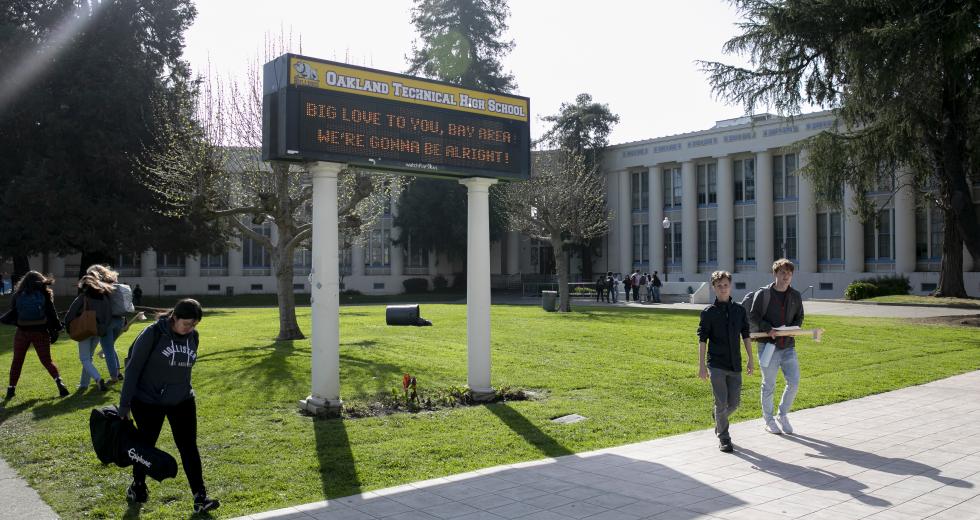In a stunning announcement that revealed disruption from the coronavirus is far from over, Gov. Gavin Newsom said Tuesday that California schools will remain closed not just until sometime next month, as most announced over the weekend, but probably for the rest of the school year.
“Don’t anticipate schools are going to open up in a week. Please don’t anticipate in a few weeks,” Newsom said. “I would plan and assume that it’s unlikely that many of these schools – few, if any – will open before the summer break.”
The governor dropped the bombshell in the middle of a wide-ranging press conference about the state’s response to the pandemic, in which Newsom also predicted severe restrictions now in place in the San Francisco Bay Area will soon spread to other regions and revealed that he had put the National Guard on alert.
Newsom also signed bills the Legislature passed Monday to spend up to $1 billion ramping up hospital capacity to handle an expected onslaught of virus-stricken patients. California, he said, had spent years preparing its health care system for an emergency such as this pandemic.
But he added that if the proportion of coronavirus patients reaches the higher end of the state’s projections, the state could need as many as 20,000 additional hospital beds — about twice the current surge capacity of 10,000. Asked about other potential shortfalls in ventilators, hospital supplies and rooms for convalescents, the governor said he’d rather not alarm Californians with more estimates.
That’s why the state is focusing on social distancing, he added. “The more we do individually will reduce those rates,” Newsom said. “We are not victims of fate. We are victims only of bad decisions.”
But schools were the big news. With millions of families already housebound and scrambling to improvise work, study and child care arrangements, Newsom said parents should not only prepare for the possibility that public schools would be closed through the end of the academic year — which runs through early to mid-June for most schools — but also to homeschool their children as part of the state’s transition to the new reality of virtual instruction.
On Monday night, he added, he had made the same sobering prediction to his daughter, who was upset at having to be separated from her friends and “expressing deep anxiety that she wasn’t in school.” She’d thrown pillows and a little bunny rabbit on the floor of her room, he said, and in an hour-long conversation, the governor told his daughter, “‘Honey, I don’t think the schools are gonna open again.’”
“If I can tell my daughter that and not tell your daughter that, or the people, then I’m not being honest and true to the people of the state of California,” Newsom said, adding: “Boy, I hope I’m wrong, but I believe that to be the case based upon the work we all have to do.”
Newsom has not made any formal orders to close schools, even though the vast majority in California have already shut down voluntarily as they figure out plans for online learning. The governor had expressed hesitance in a statewide order, saying that several schools across the state had been unprepared to deal with the logistics of transitioning to distance learning and feeding students who rely on schools for meals. In California, about 6 in 10 kids who attend public schools participate in free or reduced priced lunch programs, though in some areas, Newsom has said, the proportion is more like 80%.
Local school systems across the state have begun to create “grab-n-go” meal programs in which parents and students can go to designated school sites to pick up meals. Los Angeles, for example, has set up 60 grab-and-go centers for student meals. And Fresno Unified, the state’s fourth-largest district, is letting students pick up as many meals for their families at meal distribution centers across the city, according to The Fresno Bee.
Newsom said that the state will formally submit a waiver to the U.S. Department of Education to forgo testing, saying educators and students “shouldn’t worry about coming back and the SAT, ACT and AP, all these other exams when we already have enough anxiety related to this moment.”
Virtually all of California’s 6.2 million students have been affected by school closures. Large, urban school districts such as Los Angeles, San Diego and San Francisco had announced late last week that their schools would close, and a wave of announcements up and down the state almost immediately followed.
The duration in initial closure plans differed across school districts. Some told parents and community members they planned to be closed through the end of March, while others said to be prepared for closures through mid-April.
The governor said he expected that the handful of small and rural districts still open “will likely start to shut down.”
Homeschooling and SATs
Brianna Brown, 13, sits on the swings at Kloss park in Elk Grove,
where the coronavirus has prompted authorities to cancel school.
(Photo by Anne Wernikoff for CalMatters)
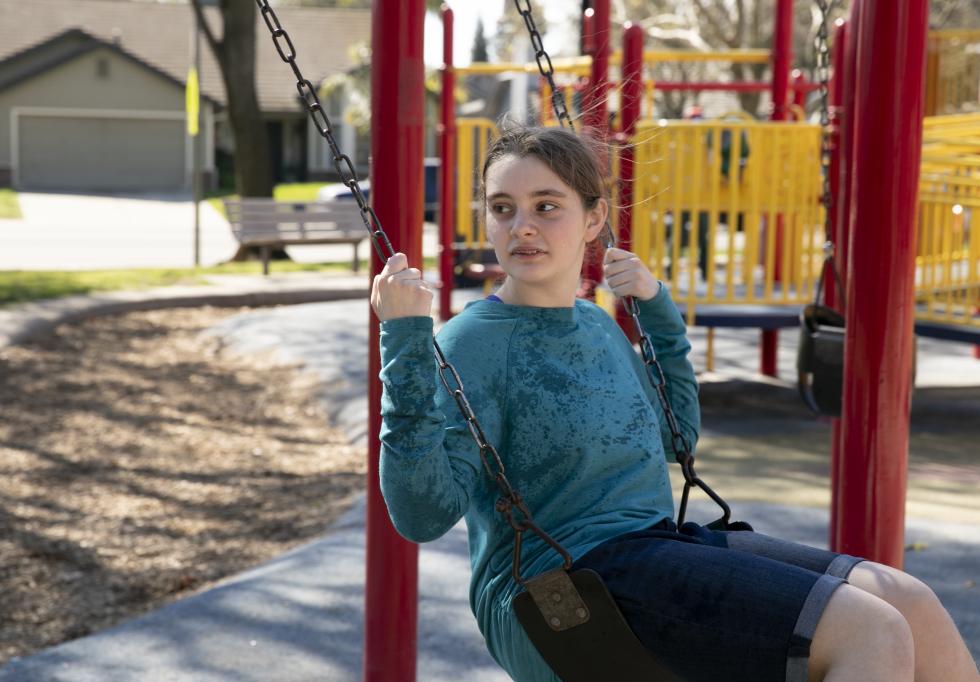
Last week, the U.S. Department of Education issued guidance to states that released them from several federally mandated testing and accountability measures. That federal guidance also stated that schools would not be required to provide special education while schools are shut down due to the pandemic unless they shift to online learning, long-term.
Newsom said a task force led by state education board president Linda Darling-Hammond and state schools superintendent Tony Thurmond is working on guidance to schools on how to continue to provide services for students with special needs “who are truly most vulnerable.”
Meanwhile, the California Department of Education on Tuesday published a list of online learning resources for schools and families. The state plans to update its guidance to schools weekly. The guidance notes that schools ought to plan for the transition to distance learning “immediately” and consider the fact that several students across the state might not have reliable access to internet.
“In these difficult times, we cannot lose track of the needs of our most disadvantaged students. LEAs (school districts) will need to solve a variety of concerns about access,” the state’s guidance reads.
Many questions remain unanswered as the state’s massive K-12 education system — 1,000 school districts serving more than 6 million children in the public schools alone — begins to absorb the news that the school year may be upended. Among them: Will summer school be available to make up lost learning? Will students have to repeat their current grade next year? And, more broadly, how will working parents adapt to the prolonged school closures and still hold onto their jobs?
Parents can use sick time to care for children whose schools have been closed by the government, according to guidance Newsom issued Tuesday, though many workers only have a few days of sick leave. Parents who can’t work because they are taking care of their children during the school closures can apply for unemployment benefits, the guidance says.
Some campuses will open for meal service or be turned into child care sites to help working parents, Newsom said, though it remains unclear how that will stem the spread of disease. If campuses are open for child care, why not open them for school? Newsom said the decisions were being made locally by districts that vary from tiny rural outposts to enormous urban centers.
Alarming Estimates
Newsom also talked about preparedness. “We’re running every conceivable model,” Newsom said.
Newsom and Mark Ghaly, secretary of California Health and Human Services would not say whether they would make these models public. But Newsom did project, with a 5% hospitalization rate, a need for 4,000 additional beds — and that’s on the low end, Newsom said. “You get up to 20%, you’re closer to 19 – 20,000 beds.”
Newsom said he’d rather not alarm anyone with more estimates. But a need for 20,000 additional beds is double what Newsom pegged the state’s current surge capacity at roughly 10,000 hospital beds. That’s why the state is focusing on social distancing. “The more we do individually will reduce those rates,” Newsom said. “We are not victims of fate. We are victims only of bad decisions.”
In other developments on Tuesday, Sacramento and Monterey counties adopted the severe restrictions already in place in Bay Area counties — requiring people to stay at home except for essential trips to get food or medicine. Newsom said he expects additional counties to adopt the rules in the coming days, but stopped short of ordering a statewide lockdown or formal order to “shelter in place.”
“If we don’t feel they are doing it quickly enough we will encourage more,” he said.
Newsom said he had put the National Guard on alert to be ready to distribute food and maintain public safety, and raised the possibility that the state could eventually move to military control if people don’t follow the guidance to stay home.
“We have the ability to do martial law, things like that, layer new requirements and authority,” he said. “If we feel the necessity to do that, we will do that.”
–
CalMatters reporter Rachel Becker contributed to this report.
CalMatters.org is a nonprofit, nonpartisan media venture explaining California policies and politics. Comstock’s is a CalMatters media partner.
Recommended For You
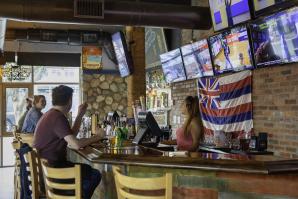
Local Businesses Struggle as Coronavirus Changes Our Daily Lives
On a bleary Monday morning in Sacramento with the Dow Jones industrial average tanking, on its way to a 2,997 point drop and its worst day since 1987, Greater Sacramento Economic Council President and CEO Barry Broome offered advice for local business owners that he knows won’t be popular.
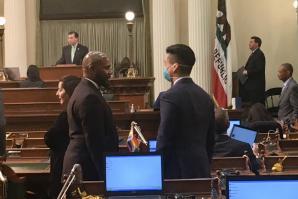
Legislature Passes $1.1 Billion in Emergency Coronavirus Funding — Then Leaves the Capitol
In an urgent attempt to prepare California for a surge of critically ill coronavirus patients, state lawmakers Monday allocated up to $1 billion for an unprecedented ramp-up of hospital capacity, and then, in an extraordinary move, went home for a month — or perhaps longer — effectively shutting down business at the state Capitol as Americans face growing calls to isolate themselves.
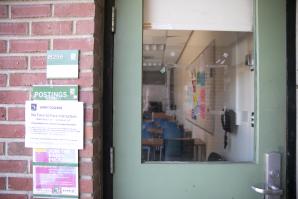
California Colleges Are Going Online. How Ready Are They?
California is about to embark on an enormous, unplanned experiment in remote learning — and no one knows how long it will last.



